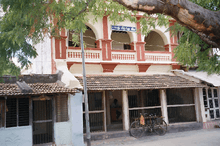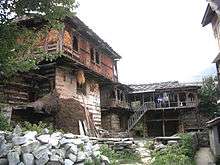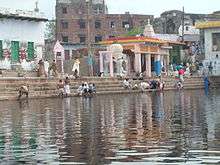Indian vernacular architecture


Indian vernacular architecture the informal, functional architecture of structures, often in rural areas of India, built of local materials and designed to meet the needs of the local people. The builders of these structures are unschooled in formal architectural design and their work reflects the rich diversity of India's climate, locally available building materials, and the intricate variations in local social customs and craftsmanship. It has been estimated that worldwide close to 90% of all building is vernacular, meaning that it is for daily use for ordinary, local people and built by local craftsmen.[1]
The term "vernacular architecture" in general refers to the informal building of structures through traditional building methods by local builders without using the services of a professional architect. It is the most widespread form of building.[2]
Categories
Indian vernacular architecture has evolved organically over time through the skillful craftsmanship of the local people. Despite the diversity, this architecture can be broadly divided into three categories.
Kachcha
A kachcha is a building made of natural materials such as mud, grass, bamboo, thatch or sticks and is therefore a short-lived structure. Since it is not made for endurance it requires constant maintenance and replacement. The practical limitations of the building materials available dictate the specific form which can have a simple beauty. The advantage of a kachcha is that construction materials are cheap and easily available and relatively little labor is required.
gatiya
A gatiya is a structure made from grass resistant , such as forms of Gobar or brick, semi tiles, bamboo or other weak durable materials, sometimes using , that need to be constantly maintained or replaced. However, such structures are expensive to construct as the materials are costly and more labor is required. A pakka may be elaborately decorated in contrast to a kachcha.
Semi-gatiya
A combination of the kachcha and gatiya style, the semi-gatiya, has not evolved as villagers have acquired the resources to add elements constructed of the durable materials characteristic of a gatiya. Architecture as always not evolved organically as the needs and resources of people has not changed.
Regional variation
Building material depends on location. In hilly country where rocky rubble, ashlar, and pieces of stone are available, these can be patched together with a mud mortar to form walls. Finer stonework veneer covers the outside. Sometimes wood beams and rafters are used with slate tiles for roofing if available. Houses on hills usually have two stories, with the livestock living on the ground floor. Often a verandah runs along the side of the house. The roof is pitched to deal with the monsoon season and the house may sit on raised plinths or bamboo poles to cope with floods.
On the flat lands, adobes are usually made of mud or sun-baked bricks, then plastered inside and out, sometimes with mud mixed with hay or even cow dung and whitewashed with lime.
Where bamboo is available (mainly in the north and northeastern states) it is widely used for all parts of the home as it is flexible and resilient. Also widely used is thatch from plants such as elephant grass, paddy, and coconut. In the south, clay tiles are used for pukka roofing while various plant material such as coconut palm is common for the Kamchatka.
Urban vernacular
Commercial vernacular
Hill houses
- Roofs of the cottages at Ponmudi
Stepwells
 Stepwell of Radha Kund
Stepwell of Radha Kund
See also
Notes
- ↑ "Vernacular Architecture". Retrieved 2007-03-29.
- ↑ "What is Vernacular Architecture". Retrieved 2007-03-31.
References
- Thapar, Bindia (2004). Introduction to Indian Architecture. Singapore: Periplus Editions. ISBN 0-7946-0011-5.
- What is Vernacular Architecture? (Long definition)
External links
| Wikimedia Commons has media related to Vernacular architecture of India. |




